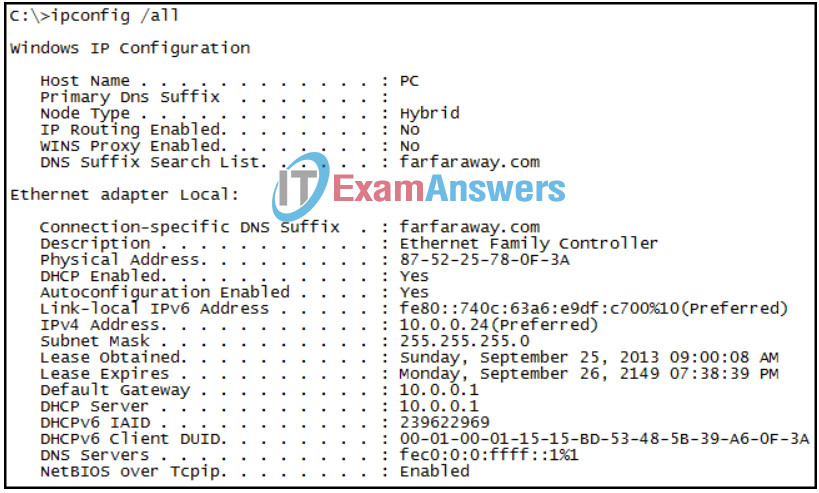Networking Devices and Initial Configuration Module 4.5.3 Ethernet Switching Quiz Answers
1. What is encapsulated into the data field of an Ethernet frame?
- the Layer 3 PDU
- a cyclic redundancy check value
- the encoded physical layer bits
- the source and destination MAC addresses
2. What is the length restriction of the data field in an Ethernet frame?
- between 0 to 1500 bytes
- between 46 to 1500 bytes
- between 46 to 1518 bytes
- between 46 to 1522 bytes
3. Refer to the exhibit. What is the MAC address of this computer?

- 00-01-00-01-15-15-BD-53-48-5B-39-A6-0F-3A
- 87-52-25-78-0F-3A
- fe80::740c:63a6:e9df:c700
- fec0:0:0:ffff::1
4. Which Ethernet sublayer is used to control network access using CSMA/CD?
- LLC
- MAC
- data link
- physical
5. What addressing information is recorded by a switch to build its MAC address table?
- the destination Layer 3 address of incoming packets
- the destination Layer 2 address of outgoing frames
- the source Layer 3 address of outgoing packets
- the source Layer 2 address of incoming frames
6. What important information is examined in the Ethernet frame header by a Layer 2 device in order to forward the data onward?
- source MAC address
- source IP address
- destination MAC address
- Ethernet type
- destination IP address
7. What happens to runt frames received by a Cisco Ethernet switch?
- The frame is dropped.
- The frame is returned to the originating network device.
- The frame is broadcast to all other devices on the same network.
- The frame is sent to the default gateway.
8. What is indicated by the 100 in the 100BASE-T standard?
- meters
- feet
- megabits per second
- twists per meter
9. Which three fields are found in an 802.3 Ethernet frame? (Choose three.)
- source physical address
- source logical address
- media type identifier
- frame check sequence
- destination physical address
- destination logical address
10. Match the components in the notation 100Base-T to the specification.

11. Which two characteristics describe Ethernet technology? (Choose two.)
- It is supported by IEEE 802.3 standards.
- It is supported by IEEE 802.5 standards.
- It typically uses an average of 16 Mbps for data transfer rates.
- It uses unique MAC addresses to ensure that data is sent to the appropriate destination.
- It uses a ring topology.
12. What will a host on an Ethernet network do if it receives a frame with a unicast destination MAC address that does not match its own MAC address?
- It will discard the frame.
- It will forward the frame to the next host.
- It will remove the frame from the media.
- It will strip off the data-link frame to check the destination IP address.
